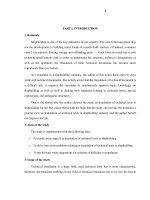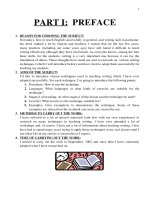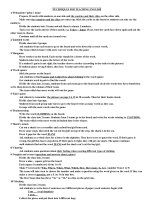TELEPHONE TECH
Bạn đang xem bản rút gọn của tài liệu. Xem và tải ngay bản đầy đủ của tài liệu tại đây (4.29 MB, 98 trang )
PRESENTS
PRESENTS
A process in which ideas,
messages and meanings
are transmitted
A process in which ideas,
messages and meanings
are transmitted
The transference and
understanding of meaning
The transference and
understanding of meaning
What is Communication?
What is Communication?
Noise Noise Noise Noise Noise Noise
Noise Noise Noise Noise Noise Noise
Noise Noise Noise Noise Noise Noise
Noise Noise Noise Noise Noise Noise
Noise Noise Noise Noise Noise Noise
Noise Noise Noise Noise Noise Noise
Noise Noise Noise Noise Noise Noise
Noise Noise Noise Noise Noise Noise
Noise Noise Noise Noise Noise Noise
Noise Noise Noise Noise Noise Noise
Noise Noise Noise Noise Noise Noise
Noise Noise Noise Noise Noise Noise
Noise Noise Noise Noise Noise Noise
Noise Noise Noise Noise Noise Noise
Noise Noise Noise Noise Noise Noise
Noise Noise Noise Noise Noise Noise
Noise Noise Noise Noise Noise Noise
Noise Noise Noise Noise Noise Noise
Noise Noise Noise Noise Noise Noise
Noise Noise Noise Noise Noise Noise
Noise Noise Noise Noise Noise Noise
Noise Noise Noise Noise Noise Noise
Noise Noise Noise Noise Noise Noise
Noise Noise Noise Noise Noise Noise
Noise Noise Noise Noise Noise Noise
Noise Noise Noise Noise Noise Noise
Noise Noise Noise Noise Noise Noise
Noise Noise Noise Noise Noise Noise
Noise Noise Noise Noise Noise Noise
Noise Noise Noise Noise Noise Noise
Noise Noise Noise Noise Noise Noise
Noise Noise Noise Noise Noise Noise
Noise Noise Noise Noise Noise Noise
Noise Noise Noise Noise Noise Noise
Noise Noise Noise Noise Noise Noise
Noise Noise Noise Noise Noise Noise
Noise Noise Noise Noise Noise Noise
Noise Noise Noise Noise Noise Noise
Noise Noise Noise Noise Noise Noise
Noise Noise Noise Noise Noise Noise
Noise Noise Noise Noise Noise Noise
Noise Noise Noise Noise Noise Noise
Noise Noise Noise Noise Noise Noise
Noise Noise Noise Noise Noise Noise
Noise Noise Noise Noise Noise Noise
Noise Noise Noise Noise Noise Noise
Noise Noise Noise Noise Noise Noise
Noise Noise Noise Noise Noise Noise
Noise Noise Noise Noise Noise Noise
Noise Noise Noise Noise Noise Noise
Noise Noise Noise Noise Noise Noise
Noise Noise Noise Noise Noise Noise
Noise Noise Noise Noise Noise Noise
Noise Noise Noise Noise Noise Noise
Noise Noise Noise Noise Noise Noise
Noise Noise Noise Noise Noise Noise
Noise Noise Noise Noise Noise Noise
Noise Noise Noise Noise Noise Noise
Noise Noise Noise Noise Noise Noise
Noise Noise Noise Noise Noise Noise
Media
Media
Sender
Sender
Encoding
Encoding
Message
Message
Decoding
Decoding
Receiver
Receiver
Response
Response
Feedback
Feedback
The Communication Process
The Communication Process
MEDIUM OF COMMUNICATION
MEDIUM OF COMMUNICATION
MEDIUM OF COMMUNICATION
MEDIUM OF COMMUNICATION
Decide your outcome
Decide your outcome
At a broader level purpose of
communication might be to:
Persuade
Inform
Motivate
Impress
Warn
Gain information
Understand feelings
Solicit opinions
Entertain
Propose
Explain
Suggest
Frighten
Summarize
Every call is an
opportunity to enhance
customer relationship
Callers on the telephone
have basic needs that
must be addressed:
To be
recognized and
remembered
To feel valued
To feel
appreciated
To feel
respected
To feel
understood
To feel
comfortable
about a want or
need
OPENING THE
CALL
PREPARE IN ADVANCE
– approaching every calling the most
positive way
SMILE THROUGH THE
PHONE
- keep a smile in your voice
ANSWER PROMPTLY
- answer by the third ring
OPENING THE CALL
(CONT’D)
GREET THE CALLER AND IDENTIFY
YOURSELF
- Callers want to know the person they
are dealing
OFFER TO HELP
- Capitalize on the positive by asking “How may I
help you”
AVOID BLIND TRANSFERS
- handling transfers professionally is the
hallmark of outstanding telephone skills
How to avoid “Blind” Transfers
1. Ask the caller whether he or she can hold or
offer to take a message.
2. Tell the caller to whom they’re being
transferred.
3. Stay on the line until your coworker
responds to the transferred call.
4. Briefly introduce the caller to the coworker
5. If a co-worker is unavailable, ask the caller
if you can take a message or if someone else
can help
MANAGING THE BODY OF THE CALL
MANAGING THE BODY OF THE CALL
LISTEN CAREFULLY AND
LISTEN CAREFULLY AND
ENTHUSIASTICALLY
ENTHUSIASTICALLY
-give customer your complete attention
-give customer your complete attention
USE THE CALLERS NAME
USE THE CALLERS NAME
- Personalizing tells the caller you are
- Personalizing tells the caller you are
paying attention
paying attention
RESPOND TO THE CALLER NEED OR
RESPOND TO THE CALLER NEED OR
REQUEST
REQUEST
- Be enthusiastic and concerned to specific
- Be enthusiastic and concerned to specific
request
request
ASK THE CUSTOMER TO HOLD
ASK THE CUSTOMER TO HOLD
How to Put a Caller on Hold
How to Put a Caller on Hold
1.
1.
Always ask the caller if he or she
Always ask the caller if he or she
can hold.
can hold.
DO SAY: Would you like to hold?
DO SAY: Would you like to hold?
2. Explain why you need to put the
2. Explain why you need to put the
caller on hold.
caller on hold.
- a simple explanation helps relax
- a simple explanation helps relax
callers
callers
3. Check back with the caller in 30-
3. Check back with the caller in 30-
second intervals.
second intervals.
DONT SAY: Hang on a
DONT SAY: Hang on a
minute
minute
CLOSING THE CALL
CLOSING THE CALL
REPEAT THE ACTION YOU AGREED TO TAKE
REPEAT THE ACTION YOU AGREED TO TAKE
Summarize the actions you and the callers
Summarize the actions you and the callers
agreed upon
agreed upon
CLOSE THE CALL FORMALLY
CLOSE THE CALL FORMALLY
Thank them for calling -end in a
Thank them for calling -end in a
professional note
professional note
SAY “GOOD-BYE” INSTEAD OF “BYE-
SAY “GOOD-BYE” INSTEAD OF “BYE-
BYE”
BYE”
When callers are treated with courtesy
When callers are treated with courtesy
Callers believe that they are
Callers believe that they are
talking to someone competence
talking to someone competence
DO:
DO:
Use common
Use common
predetermined
predetermined
courtesies
courtesies
such as please,
such as please,
thank you
thank you
Listen
Listen
objectively-
objectively-
regardless of
regardless of
the caller’s
the caller’s
concern
concern
DON’T:
DON’T:
Have a mind
Have a mind
set about
set about
caller
caller
React
React
negatively to
negatively to
the
the
customer’s
customer’s
problems
problems
DO:
DO:
Control
Control
backgroun
backgroun
d noises
d noises
Demonstrate
Demonstrate
‘can do’
‘can do’
attitude
attitude
DON’T:
DON’T:
Use
Use
industry
industry
jargon
jargon
Get easily
Get easily
annoyed or
annoyed or
irritated
irritated
Key to excellent service on the phone
Key to excellent service on the phone
Quick response but never
Quick response but never
At the expense of quality
At the expense of quality
DO:
DO:
Get to the point
Get to the point
quickly
quickly
Predict how long a
Predict how long a
follow-up action is likely
follow-up action is likely
to take
to take
Do what you say you are going
Do what you say you are going
to do- strengthen your follow
to do- strengthen your follow
through
through
DON’T:
DON’T:
Have conversation with idle
Have conversation with idle
chatter
chatter
Take more than 24 hours to
Take more than 24 hours to
return a call
return a call
Fail to call if a promised
Fail to call if a promised
action is going to be delayed
action is going to be delayed
or impossible to take
or impossible to take
Forget to follow through on
Forget to follow through on
promised action
promised action
Callers know they are dealing with
Callers know they are dealing with
“
“
experts” in any given situation
experts” in any given situation
Callers understand important
Callers understand important
information more efficiently
information more efficiently
DO:
DO:
Continue to enhance
Continue to enhance
your product expertise
your product expertise
Improve your telephone
Improve your telephone
service
service
Use references in an
Use references in an
efficient way
efficient way
Use easy-to-understand
Use easy-to-understand
examples and analogies to
examples and analogies to
explain complex issues
explain complex issues









